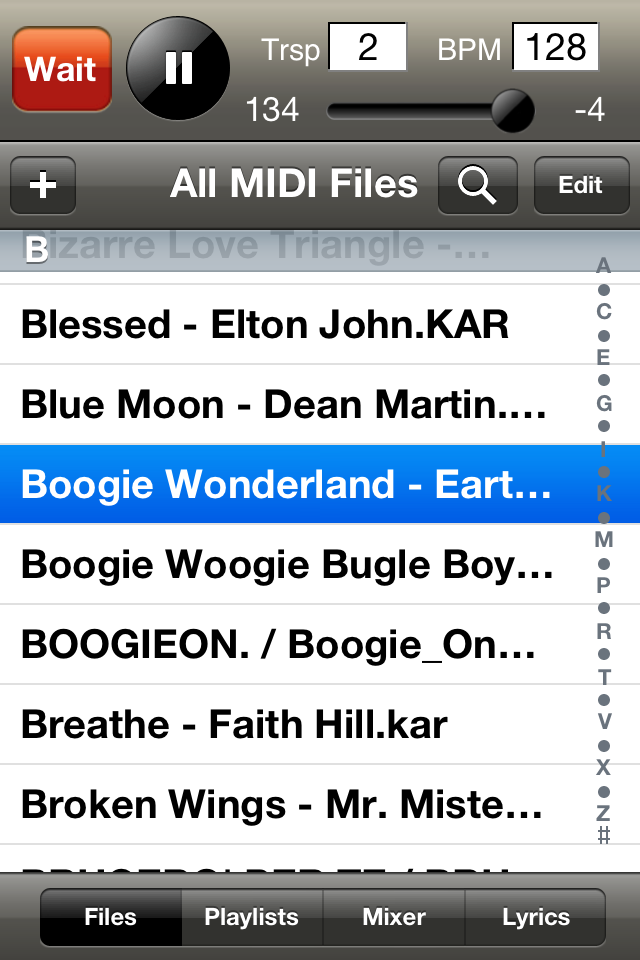

- #Sweet midi player ipad how to#
- #Sweet midi player ipad pdf#
- #Sweet midi player ipad driver#
- #Sweet midi player ipad code#
- #Sweet midi player ipad professional#
Can I use your program's source code for my program?

#Sweet midi player ipad driver#
His driver is definitely more stable than mine, and it's easier to use too. If you want something easy to use, I strongly recommend VirtualMIDISynth 2.x by Claudio Nicora.

I've seen newbies getting angry at me after changing one settings, complaining that the driver kept crashing their apps while they were playing MIDIs/working on projects.
#Sweet midi player ipad how to#
I'll be honest, when I programmed the interface of the driver, I made it to make it familiar for DAW experts or people who know how to use advanced programs.
#Sweet midi player ipad professional#
What do you mean by "for professional use"? It's meant for professional people who wants a lot of settings to change almost every behaviour of the program. Constant updates, to keep the driver fresh and always up-to-date to users requests.Each core hosts a vital part of the driver: The first thread hosts the settings loader, the debug info writer etcetera, the second hosts the MIDI event parser, the third hosts the audio render and the fourth hosts the ASIO driver (When using the ASIO engine). The ability to use up to 4 cores/threads, to ensure each function is executed at its best.Spartan user interface, no "fancy graphics" which can distract the user from the original purpose of the driver, and designed for people who aims for features more than for style.The driver will always try to give you the best audio quality, no matter what MIDI you're trying to play. What's so special about your driver that makes it different from the others out there? I've received numerous donations from people that don't want the driver to be abandoned, and I'm really thankful to all of them for their support! Ok ok, enough of your story. Yes, but I still do small updates from time to time when needed, and I also do updates on request. If you're a programmer, and you have some ideas on how to improve or expand the driver's functionalities, please hit me up or send a pull requests with the edits. I mean, there's always room for improvement.īut I feel like I have nothing else to add to it at this point, I'm literally out of ideas. (Which I eventually replaced, but still.)ĭo you feel like your driver is complete now? He helped me a lot with some issues I was having with some parts of his code. Oh, and of course, the driver wouldn't be where it is now, without kode54's help from behind the scenes. (While still giving credits to kode54, of course.) I really didn't want to ruin kode54's original source code, so I decided to create my own repository. The driver was born back in 2015, when a friend of mine wanted a version of BASSMIDI Driver with higher polyphony, but then I started working on it more and more, to the point where most of the original source code got replaced by mine. But I honestly didn't want to ruin the original driver. Couldn't you just edit the driver on the existing repository? Was it really necessary to create a complete separate fork of BASSMIDI Driver? Note that the appropriate cloud drive client app has to be installed for this to work.A reboot of the original BASSMIDI Driver by Kode54, with more features.į.A.Q. * Note on Export / Import: All major cloud drives supported: iCloud, Dropbox, Google Drive, One Drive.
#Sweet midi player ipad pdf#
*Įxport as MIDI, MusicXML, audio (M4A / AAC, MP3, WAV), PDF to cloud drives *, directly to other apps or via AirDrop All the common image types supported: PNG, JPG, TIFF, etc. Reads and recognizes the following symbols of musical notation pertaining to melody, harmony, and rhythm: treble, bass, and alto (viola) clefs, notes including ties, duration dots, rests, accidentals, repeat signs, and triplets / tuplets. Supports pitch shift / sound transposition by semitones up to 2 octaves up or down Supports actual instrument pitch for the transposing instruments right or left piano handĬhange your pitch standard based on instrument, from standard 440Hz to 380-480 HzĪccommodates speeds between 50 and 330 beats per minuteĪccommodates the instruments: Accordion, Acoustic Bass, Alto Sax, Bagpipes, Banjo, Bass Guitar, Celeste, Cello, Choir, Clarinet, Double Bass, Flute, French Horn, Guitar – Classical, Clean, Distortion, Glockenspiel, Harp, Mandolin, Marimba, Oboe, Organ (Percussive, Pipe, Reed, Rock, Tonewheel), Piano, Recorder, Tenor Sax, Trombone, Trumpet, Tuba, Vibraphone, Viola, Violin, Xylophone Support for playing individual staffs separately, e.g. both piano hands at the same time, or all the choir voices Support for voices played in tandem, e.g. Notes and symbols are highlighted as they’re played

Playback from anywhere in the song – simply tap the bar Scan and playback from any image in your image library or from a PDF in you cloud drive Scan the whole sheet instantly using your built-in camera


 0 kommentar(er)
0 kommentar(er)
